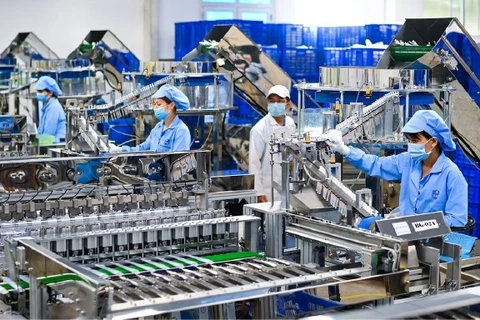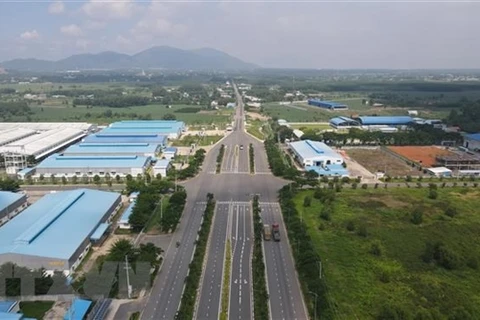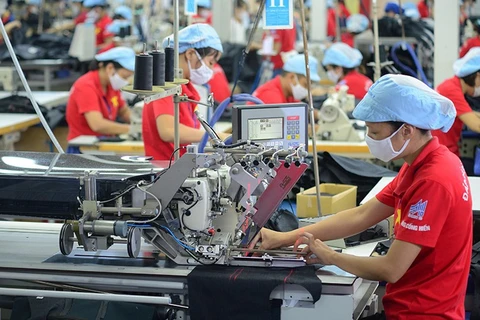Hanoi (VNS/VNA) - Vietnam attracted nearly 5.45 billion USD worth of foreign investment in the first quarter of the year, down 39% year-on-year, according to the Foreign Investment Agency (FIA) under the Ministry of Planning and Investment.
Of the three-month figure, over 3 billion USD came from 522 newly-licensed projects, up 62% in a number of projects but down 6% in the amount of capital compared to the same period last year.
Some 1.2 billion USD was added to 228 existing ones, representing a yearly hike of 3% in a number of projects and a yearly decline of 70.3% in the capital.
However, foreign investors' capital contribution and share purchases rose 4% year-on-year to 798 million USD, the FIA said.
Along with the contraction in fresh capital, the disbursed capital also slightly plunged 2.2% from a year earlier to 4.3 billion USD, it noted.
The most significant proportion of the period's foreign investment, 4 billion USD or 73%, landed in processing and manufacturing, followed by real estate, with 766 million USD or 14.1%.
In Q1, Singapore topped foreign investors, pouring 1.69 billion USD into Vietnam or equivalent to 31% of the nation's total foreign investment. It was followed by mainland China (552 million USD) and Taiwan (477 million USD).
According to the FIA, newly foreign-invested projects still came towards localities that had many advantages in attracting foreign investment such as good infrastructure, stable human resources, efforts to reform administrative procedures and dynamism in investment promotion. They included Bac Giang, Dong Nai, Bac Ninh, HCM City and Hai Phong.
For example, Dong Nai province lured 500 million USD in foreign investment in the first three months, nearly tripling that in the same period last year, the provincial industrial parks management board has said.
Of the figure, there were 11 new projects with a total registered capital of nearly 50 million USD and 22 others with additional capital of more than 451 million USD, mainly from Japan, the Republic of Korea and Taiwan (China). All of them utilise advanced technology and skilled labour in priority investment sectors. Among the 11 new foreign-invested projects, six were in supporting industry.
Deputy head of the board Pham Van Cuong said over recent months, foreign investment attraction in Dong Nai has thrived with increasing quantity and quality of projects which involve the construction of new factories and manufacturing expansion.
Foreign investors pin high hope on projects underway in the province, especially Long Thanh airport and expressways. He said the province has also stepped up administrative reform and dealt with investor concerns.
According to the approved plan, Dong Nai has 40 industrial parks (IPs) with an area of about 19,000ha. The province is now home to 32 IPs already in operation, with an occupancy rate of over 85%. The remaining IPs are yet to be built due to obstacles regarding investment procedures, rubber and forest land processing, auction and bidding, and zone planning.
Cuong said the province hoped that the Government, ministries and agencies would tackle bottlenecks and create favourable conditions for it to establish new IPs, thus attracting more capital from big corporations and businesses world-wide./.
Of the three-month figure, over 3 billion USD came from 522 newly-licensed projects, up 62% in a number of projects but down 6% in the amount of capital compared to the same period last year.
Some 1.2 billion USD was added to 228 existing ones, representing a yearly hike of 3% in a number of projects and a yearly decline of 70.3% in the capital.
However, foreign investors' capital contribution and share purchases rose 4% year-on-year to 798 million USD, the FIA said.
Along with the contraction in fresh capital, the disbursed capital also slightly plunged 2.2% from a year earlier to 4.3 billion USD, it noted.
The most significant proportion of the period's foreign investment, 4 billion USD or 73%, landed in processing and manufacturing, followed by real estate, with 766 million USD or 14.1%.
In Q1, Singapore topped foreign investors, pouring 1.69 billion USD into Vietnam or equivalent to 31% of the nation's total foreign investment. It was followed by mainland China (552 million USD) and Taiwan (477 million USD).
According to the FIA, newly foreign-invested projects still came towards localities that had many advantages in attracting foreign investment such as good infrastructure, stable human resources, efforts to reform administrative procedures and dynamism in investment promotion. They included Bac Giang, Dong Nai, Bac Ninh, HCM City and Hai Phong.
For example, Dong Nai province lured 500 million USD in foreign investment in the first three months, nearly tripling that in the same period last year, the provincial industrial parks management board has said.
Of the figure, there were 11 new projects with a total registered capital of nearly 50 million USD and 22 others with additional capital of more than 451 million USD, mainly from Japan, the Republic of Korea and Taiwan (China). All of them utilise advanced technology and skilled labour in priority investment sectors. Among the 11 new foreign-invested projects, six were in supporting industry.
Deputy head of the board Pham Van Cuong said over recent months, foreign investment attraction in Dong Nai has thrived with increasing quantity and quality of projects which involve the construction of new factories and manufacturing expansion.
Foreign investors pin high hope on projects underway in the province, especially Long Thanh airport and expressways. He said the province has also stepped up administrative reform and dealt with investor concerns.
According to the approved plan, Dong Nai has 40 industrial parks (IPs) with an area of about 19,000ha. The province is now home to 32 IPs already in operation, with an occupancy rate of over 85%. The remaining IPs are yet to be built due to obstacles regarding investment procedures, rubber and forest land processing, auction and bidding, and zone planning.
Cuong said the province hoped that the Government, ministries and agencies would tackle bottlenecks and create favourable conditions for it to establish new IPs, thus attracting more capital from big corporations and businesses world-wide./.
VNA























